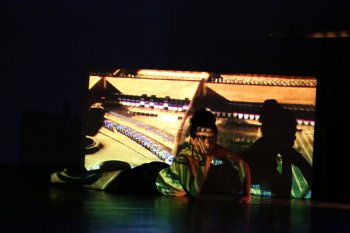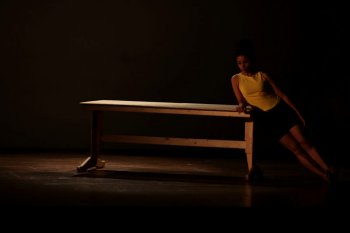 |
 |
Light doesn’t have arms to carry us - Rakesh Khanna May 15, 2013 About ten minutes into a Preethi Athreya show, a few people invariably start walking out. It’s too weird for them. Or it’s too arty or modern, too whatever - not their kind of thing, anyway. They try their best to leave quietly, but because there’s pin-drop silence on stage, everyone can hear their chairs squeak and their clothes rustle and the latch of the hall doors as they click open and shut. Once a couple of people have left, though, it emboldens others, and there’s a little trickle of people out the door until about twenty minutes in, after which things stabilize. The first time I saw Athreya perform, I felt a little bad for her at this ten-minute-mark exodus. It’s got to be tough to dance alone, silent, on a bare stage, in front of a hall full of people. I was fairly sure she was thick-skinned enough that her feelings wouldn’t be hurt, but I still worried the disturbance might shake her concentration, unsteady her. Now I have watched her dance a few times, and I know better than to worry. You couldn’t unsteady Preethi Athreya if you filled the auditorium with a troop of jackhammer-wielding chimpanzees. Work is the word Athreya invariably uses when she discusses her choreography, and when you see her dance it’s clear that she has done - is doing - serious work. Partly it’s her penchant for repetitive sequences of movements (or almost-repetitive-but-subtly-permuted sequences of movements) that leave this impression. Partly it’s the deliberation behind each stance and each action, the treatment of each flex and each release of each muscle as a discrete vector that seems to have been mentally plotted with respect to the orthogonal basis of some dizzyingly high-dimensional space. Athreya on stage is like a mathematician working to formulate a profound combinatoric theorem, up all night at the chalkboard calculating the automorphism groups of various algebraic structures so as find their most elegant classification. Or else she’s a miner; not the modern corporate-behemoth landscape-destroying kind, but a rugged 19th century prospector off alone in the mountains with a pickaxe, following a tiny vein deeper and deeper underground, in the conviction that it leads to large deposits of an extremely rare and magical crystal just a little bit further down. This is rigorous labour, performed with intense conviction. Light Doesn’t Have Arms to Carry Us, performed in Chennai in March, is her fifth solo work. It takes its title from an idiosyncratic piece of piano music, La lumière n'a pas de bras pour nous porter written by the French composer Gérard Pesson, which is incorporated into the performance by means of a video projection. Light opens with an atmospheric video of what appears to be flickering close-ups of patches of light and shade on asphalt, accompanied by an equally atmospheric audio track of gravelly rustling noises. I learn later that this is the sound of Athreya’s father’s wheelchair being rolled over a sandy surface (he has been afflicted with Parkinson’s disease for many years). The video, as well, was shot using the wheelchair as a dolly. When Athreya appears on stage, she’s in a short red dress with her arms held inside the sleeves, wearing the blank expression of a store mannequin recently brought to life. She looks a bit ridiculous, like a silly kid playing dress-up who has decided to pretend that she has no arms. Something in her attitude lets us know the ridiculousness is acknowledged, but quickly, in passing. There’s no need to dwell on it - it’s just one of the basic assumptions of our logical system. Axiom: The entire universe, and in particular all contemporary art, is fundamentally absurd. We proceed from these first principles.  The video and audio fade out, and she is in a spotlight now. She rotates
slowly, leans backwards, shifts into poses that might hint at running,
or pregnancy, or shame. Then her knees angle inward and she looks out at
the audience with a strange glare that seems simultaneously indignant
and fearful. Then the poses appear to repeat, though not in exactly the
same order. This is a trademark of Athreya’s work, these not-quite
patterns, the dance equivalents of Chomskyan formal grammars or
Lindenmayer systems. The video and audio fade out, and she is in a spotlight now. She rotates
slowly, leans backwards, shifts into poses that might hint at running,
or pregnancy, or shame. Then her knees angle inward and she looks out at
the audience with a strange glare that seems simultaneously indignant
and fearful. Then the poses appear to repeat, though not in exactly the
same order. This is a trademark of Athreya’s work, these not-quite
patterns, the dance equivalents of Chomskyan formal grammars or
Lindenmayer systems.The different sections of the dance are separated from each other by video projections of three performances of La lumière n'a pas de bras pour nous porter by pianist Christine Chareyron. Except, in the first video, instead of a piano, she’s playing the piece on a wooden table using the exact finger movements but sounding no notes. In the second video, she’s silently conducting the piece, but we can’t hear it. When we finally see and hear the piece played in its entirety on a grand piano, we realize that the music calls for the pianist to brush her hands rhythmically over the keys, only rarely actually pressing them, so that the piece is dominated by a pitchless waltz beat, punctuated now and then by high register note-clusters of the C-major scale. They sound like little stars. At one point Athreya is pushing a real wooden table around the bare stage, excruciatingly slowly. First she pushes it with her hip; then she pushes it with her neck. Now she’s stopped, motionless. Now she’s leaning against the table at a 45 degree angle and kind of rotating slowly backwards around it while keeping her hip tangent to the edge. Now she’s still once more. There’s no music for this section, just the intermittent sliding noise of the table on the stage. (It’s at this point that the faint-hearted in the audience get up to leave.) Later, in one of the piece’s fiercest moments, she’s again dressed as the armless mannequin, but now in a blue dress. Scraping her toes and stomping her heels, she takes up the gentle waltz rhythm of the piano but makes it furious, whirling around the stage like a mad, disfigured martial artist.  Near the end of the piece is a section where Athreya, now in a tank top
and shorts, goes through another repeated/permuted sequence of movements
– this one much faster-paced, with more of her Bharatanatyam training
on display, featuring poses that bring to mind Nataraja or the archers
of the Ramayana - while speaking a text, a meditation or
thought-exercise exploring the various meanings of each of the words of
the title. This is the varnam of the performance, and its form is
another Athreya trademark. Her previous work Sweet Sorrow, contained a
similarly climactic section combining speech and a sequence of
sign-language-like hand motions. In that piece as in this one, she
speaks the text in the neutral voice of a documentary narrator, or the
woman who reminds you to close the door in the lift; there is an uncanny
calmness in the delivery that contrasts drastically with the
accompanying bodily contortions. In Sweet Sorrow both the tempo of the
recital of the text and the tempo of the hand movements were modulated
along perfect sine curves, but phase-shifted and clashing; aside from
being mesmerizing to watch, this appeared so phenomenally technically
difficult that I found myself wondering if Athreya had built a robot
double of herself. In Light, she’s not just moving her hands but
exerting her whole body while speaking, which looks, if possible, even
more jaw-droppingly hard to do. The only proof that she’s still human is
the slight breathlessness that creeps into her otherwise even voice as
she holds forth on the subjects of photons, time dilation, and firearms
licenses. Near the end of the piece is a section where Athreya, now in a tank top
and shorts, goes through another repeated/permuted sequence of movements
– this one much faster-paced, with more of her Bharatanatyam training
on display, featuring poses that bring to mind Nataraja or the archers
of the Ramayana - while speaking a text, a meditation or
thought-exercise exploring the various meanings of each of the words of
the title. This is the varnam of the performance, and its form is
another Athreya trademark. Her previous work Sweet Sorrow, contained a
similarly climactic section combining speech and a sequence of
sign-language-like hand motions. In that piece as in this one, she
speaks the text in the neutral voice of a documentary narrator, or the
woman who reminds you to close the door in the lift; there is an uncanny
calmness in the delivery that contrasts drastically with the
accompanying bodily contortions. In Sweet Sorrow both the tempo of the
recital of the text and the tempo of the hand movements were modulated
along perfect sine curves, but phase-shifted and clashing; aside from
being mesmerizing to watch, this appeared so phenomenally technically
difficult that I found myself wondering if Athreya had built a robot
double of herself. In Light, she’s not just moving her hands but
exerting her whole body while speaking, which looks, if possible, even
more jaw-droppingly hard to do. The only proof that she’s still human is
the slight breathlessness that creeps into her otherwise even voice as
she holds forth on the subjects of photons, time dilation, and firearms
licenses.Discussions of modern dance are often sprinkled with annoyingly flowery words and phrases like “expressing passions”, “liberating the soul”, and especially “freedom.” Athreya’s work is in direct opposition to this aesthetic. She operates in a world of confinement and constraint. A voluntary confinement, perhaps, as with the mathematician locked in a tiny classroom, or the miner in her tunnel. Or perhaps not: in this piece, the recurring image of the double amputee, the talismanic use of her father’s wheelchair, the title itself, all seem to hint at a theme of disability or handicap. Which is why the video footage at the very end seems so…well, liberating. First we see the alternating white-and-black pattern painted on a Chennai street curb rush by; it creates beat frequencies with the frame rate, producing a sort of found urban Gysin dream machine. Then we see Athreya on the Adyar Bridge at dawn, walking past the brightly painted statue of the ferocious yali flanked by two bikini clad apsaras. (I give a little silent cheer at this: I cross that bridge almost every day, and have admired the kitschy awesomeness of the statue for a long time.) After so much constrained otherworldliness, after all the close-ups and tight spotlights, this sudden visual of the familiar, garish outdoors feels like rush of oxygen. We’ve been toiling underground in near-darkness for 50 minutes, and now suddenly we’re out in the open. It’s morning time. The theorem has been proved. Q.E.D. I’m far from understanding the exact nature of that abstract jewel that Athreya has been mining for all this time. But I believe she has now found it. Rakesh Khanna studied contemporary percussion music at the University of California, Santa Cruz before switching to mathematics and moving to Chennai, where he co-founded the alternative publishing house Blaft in 2007. He is the editor of The Blaft Anthology of Tamil Pulp Fiction Vols. 1 and 2 and co-editor of the comics-and-visual-arts collection The Obliterary Journal. |